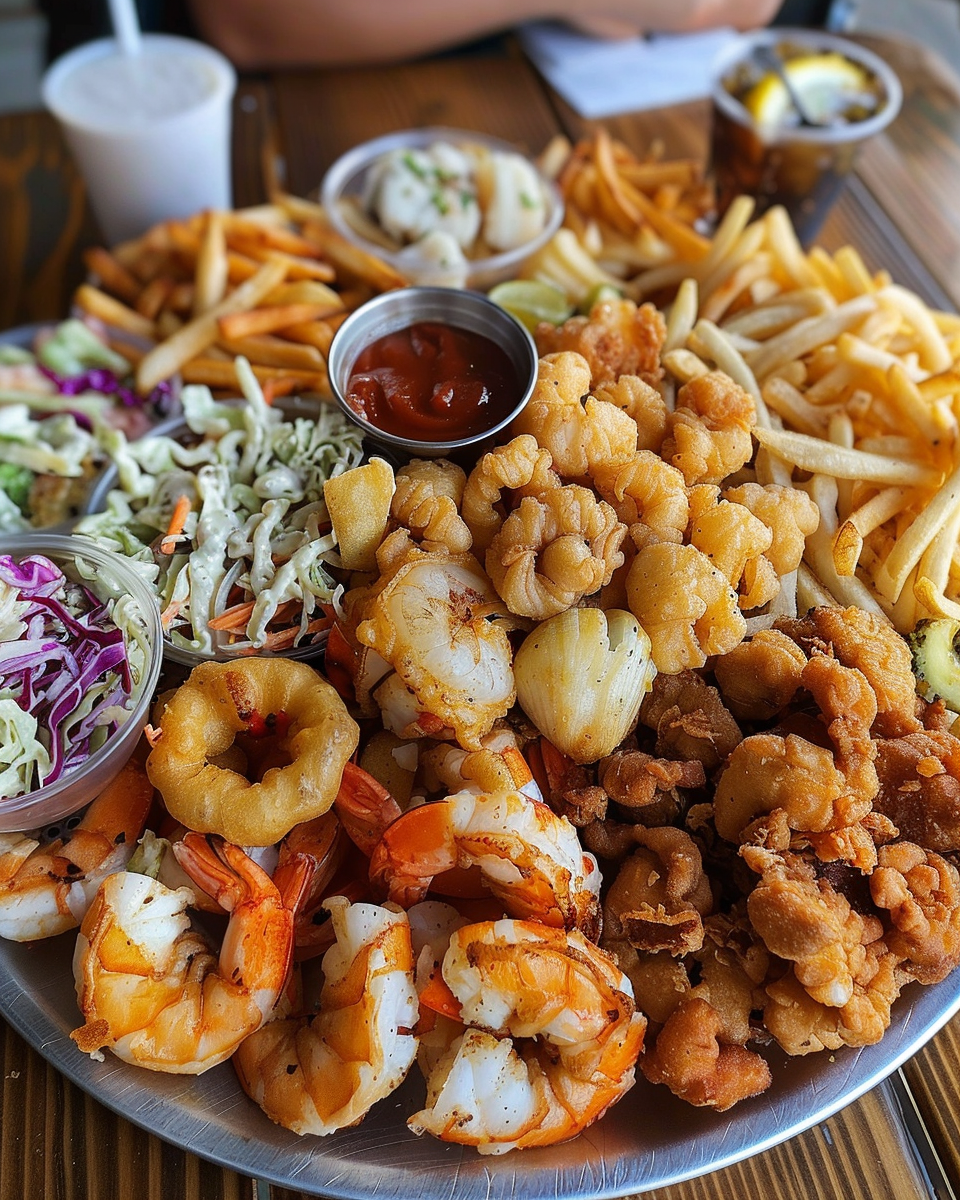Introduction
Hook:
There’s something irresistibly satisfying about a well-prepared fried seafood platter. It’s a delightful medley of various seafood types, each encased in a golden, crispy coating. This dish not only tantalizes your taste buds but also offers a visually appealing centerpiece perfect for gatherings, celebrations, or a weekend indulgence.
Brief History of Fried Seafood:
The origins of fried seafood are deeply rooted in Southern U.S. cuisine, where deep-frying was a popular method of cooking. This technique quickly spread to coastal European regions, where it was embraced and adapted to local seafood varieties. Both cultures perfected the art of coating seafood in a seasoned flour mixture and frying it until crispy, making it a cherished dish known for its delicious taste and easy preparation.
Why Choose a Fried Seafood Platter?
A fried seafood platter is a crowd-pleaser, bringing together an assortment of seafood items that each offer distinct flavors and textures. The crispy exterior adds a satisfying crunch, while the tender, succulent interior of each seafood type provides a delightful contrast. This dish’s combination of taste and visual appeal makes it a standout option for any meal.
Modern Appeal:
Today, fried seafood platters are a hit in both casual seafood eateries and upscale dining establishments. Their versatility caters to a wide range of preferences, from laid-back, casual meals to more refined dining experiences. This dish’s ability to adapt to various dining settings while maintaining its universal charm makes it a favorite across different culinary landscapes.
Ingredients
Overview:
The foundation of a great fried seafood platter lies in the quality and freshness of its ingredients. Selecting the right seafood and preparing a flavorful coating are essential steps in achieving a delectable dish.
Seafood Selection:
- Shrimp:
Choose large or jumbo shrimp with a firm texture. They should be peeled and deveined, though keeping the tails on can enhance presentation. Freshness is key to a satisfying crunch. - Oysters:
Opt for fresh oysters with tightly closed shells. Carefully shuck them, making sure to preserve as much of the oyster liquor as possible to enhance the flavor. - Clams:
Select fresh clams that are clean and tightly closed. Scrub them thoroughly to remove any sand or grit before cooking. Fresh clams offer a sweet, briny flavor that complements the fried coating. - Calamari (Squid):
Use fresh or frozen calamari rings. If using frozen, thaw them completely and pat them dry to remove excess moisture, which can cause the coating to become soggy.
Batter and Coating:
- Flour:
All-purpose flour creates the base of the batter, forming a light, crisp coating. It helps the other ingredients adhere to the seafood. - Cornstarch:
Incorporating cornstarch into the flour mixture enhances the crispiness of the coating. It contributes to a lighter, airier texture that contrasts beautifully with the seafood’s tenderness. - Seasonings:
Season the flour with salt, pepper, paprika, garlic powder, and any other desired spices. These seasonings add depth and flavor to the coating, complementing the seafood. - Eggs:
Beaten eggs act as a binder, allowing the dry coating to adhere to the seafood. They also contribute to a crispier finish. - Breadcrumbs:
Use panko breadcrumbs for a lighter, crunchier texture, or regular breadcrumbs for a more traditional coating. Both types add an extra layer of crispiness.
Cooking Oil:
- Types of Oil:
Choose oils with high smoke points, such as vegetable oil or canola oil. These oils can withstand the high temperatures required for frying without burning or imparting unwanted flavors. - Oil Temperature:
Maintaining an oil temperature of 350°F (175°C) is crucial for achieving a crispy, golden coating. Use a kitchen thermometer to ensure the oil remains at the correct temperature throughout the frying process.
Optional Accompaniments:
- Dipping Sauces:
Classic choices include tartar sauce, cocktail sauce, and remoulade. Each sauce adds a unique flavor profile, enhancing the overall dining experience. - Lemon Wedges:
Fresh lemon wedges provide a zesty brightness that cuts through the richness of the fried seafood, adding a refreshing contrast.
Instructions (Step-by-Step)
Step 1: Preparing the Seafood
- Cleaning and Prepping:
Thoroughly clean and devein the shrimp, shuck the oysters, and scrub the clams. Pat all seafood dry with paper towels to ensure a crispy coating and avoid excess moisture. - Marinating (Optional):
For added flavor, marinate the seafood in a mixture of lemon juice, garlic, and herbs. While this step is optional, it can enhance the taste and add an extra layer of complexity.
Step 2: Making the Batter and Coating
- Preparing the Dry Mix:
In a large bowl, combine all-purpose flour, cornstarch, and seasonings. Mix thoroughly to ensure an even distribution of flavors. This mixture forms the first layer of the coating. - Preparing the Wet Mix:
In a separate bowl, beat the eggs until well combined. This mixture will help the dry coating adhere to the seafood and contribute to a crispier texture. - Coating the Seafood:
Dredge each piece of seafood in the dry mix, ensuring an even coating. Dip in the beaten egg, then coat with breadcrumbs. Press gently to ensure the coating sticks well and adheres uniformly.
Step 3: Heating the Oil
- Oil Preparation:
Heat a generous amount of oil in a deep fryer or large skillet to 350°F (175°C). Use a kitchen thermometer to monitor the temperature accurately and maintain consistency. - Test for Readiness:
Test the oil by dropping a small piece of seafood or a crumb of bread into it. The oil should sizzle and the test piece should float to the surface, indicating that the oil is ready for frying.
Step 4: Frying the Seafood
- Frying Shrimp:
Fry the shrimp in batches to avoid overcrowding. Cook for 2–3 minutes or until they turn golden brown and crispy. Remove with a slotted spoon and drain on paper towels to remove excess oil. - Frying Oysters:
Fry the oysters until the coating is crispy and the oysters are opaque, usually about 2–3 minutes. Ensure they are cooked evenly for the best texture. - Frying Clams:
Fry clams until they are golden brown and crispy, typically around 2–3 minutes. Drain on paper towels to maintain crispiness. - Frying Calamari:
Fry calamari rings for 2–3 minutes, or until they are crispy and lightly golden. Avoid overcooking to prevent the calamari from becoming tough.
Step 5: Draining and Serving
- Draining Oil:
Use a wire rack or paper towels to drain excess oil from the fried seafood. This helps maintain its crispiness and prevents it from becoming greasy. - Serving:
Arrange the fried seafood on a large platter. Garnish with lemon wedges and fresh parsley for a touch of color and freshness. Serve with your choice of dipping sauces for added flavor.
Serving Suggestions
Presentation:
- Platter Arrangement:
Arrange the fried seafood attractively on a large platter. This not only enhances the dish’s visual appeal but also ensures easy access for sharing among guests. - Garnishes:
Add lemon wedges and fresh parsley for a burst of color and a hint of freshness. Consider sprinkling additional seasoning if desired for extra flavor.
Side Dishes:
- French Fries or Onion Rings:
Serve the seafood with classic sides like crispy French fries or onion rings. These sides complement the fried seafood and create a complete meal. - Coleslaw:
A refreshing coleslaw provides a crunchy, tangy contrast to the richness of the fried seafood. It adds a refreshing element to the platter. - Pickles:
Pickles offer a tangy bite that enhances the fried flavors and adds variety to the platter. They provide a delightful contrast to the rich seafood.
Beverage Pairings:
- Beer Pairing:
Pair the fried seafood with a crisp lager or pale ale. These beers complement the seafood’s flavors without overpowering them. - Wine Pairing:
Opt for a chilled Sauvignon Blanc or a sparkling wine to balance the richness of the fried seafood. These wines offer a refreshing contrast to the dish. - Non-Alcoholic Options:
Sparkling water with a lemon wedge or a cold ginger ale are refreshing choices that work well with the meal, providing a light and invigorating complement.
Conclusion
Recap of the Recipe:
Summarize the process of preparing a fried seafood platter, from selecting and prepping the seafood to frying and serving. Highlight the essential steps for achieving a flavorful and visually appealing dish.
Why You Should Try This Recipe:
Emphasize the joy of creating and sharing a fried seafood platter at home. The combination of different seafood types and crispy coatings makes for a versatile and satisfying meal.
Final Thoughts:
Encourage readers to experiment with different seafood varieties and dipping sauces. Suggest that this dish is ideal for both casual meals and special occasions, offering a delightful culinary experience that can be tailored to individual preferences.
FAQs
What types of seafood are best for a fried seafood platter?
Popular choices include shrimp, oysters, clams, and calamari. Each type contributes unique flavors and textures, creating a well-rounded and enjoyable platter.
Can I use frozen seafood?
Yes, but ensure it is properly thawed and thoroughly dried to prevent excess moisture, which can lead to a soggy coating. Proper preparation is key to maintaining a crispy texture.
How do I achieve a crispy coating?
Ensure the oil is at the correct temperature (350°F/175°C), use cornstarch in the batter, and avoid overcrowding the pan. These steps help maintain a crispy coating throughout the frying process.
What is the best oil for frying seafood?
Vegetable oil and canola oil are ideal due to their high smoke points and neutral flavors. They prevent the oil from burning and affecting the taste of the seafood.
How do I store leftovers?
Store leftover seafood in an airtight container in the refrigerator for up to 2 days. Reheat in an oven to restore some of the crispiness lost during storage.
Can I make the seafood platter in advance?
For the best results, fry the seafood just before serving. However, you can prep and coat the seafood in advance and fry it later to maintain its crispiness.
What are some good dipping sauces for fried seafood?
Tartar sauce, cocktail sauce, and remoulade are traditional options. Each sauce enhances the flavor of the seafood and complements the dish beautifully.
How do I know when the oil is at the right temperature for frying?
Use a kitchen thermometer to ensure the oil reaches 350°F (175°C). Alternatively, test with a small piece of seafood or a crumb of bread; it should sizzle and float to the surface, indicating the oil is ready.

